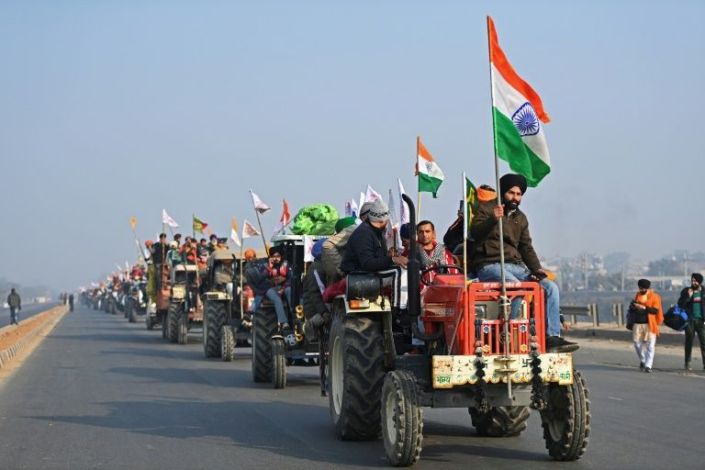Thousands of Indian farmers fought street battles with police across New Delhi on Tuesday as they took protests against agriculture reforms into the capital during a giant Republic Day military parade.
Police laid on one of their biggest security operations in years in a bid to keep demonstrators away from Prime Minister Narendra Modi and other government and military leaders.
But after barging through barricades on main roads into the city, convoys of farmers on tractors took over Delhi landmarks and debris-strewn streets were left in clouds of tear gas.
One farmer was killed in what police said was an accident after his tractor overturned. Police said they suffered “many” casualties but gave no figures.
At the 400-year-old Red Fort, farmers put up their own emblem on the flagpole where India’s tricolour normally flies on national days. They were chased out by security forces.
Hundreds fought police outside the Delhi police headquarters.
All over the city, security forces fired tear gas and staged baton charges. But the farmers also laid into police with branches and metal bars and hijacked buses that had been used to block their convoys.
As night fell, authorities cut internet and phone links in the areas on the edge of Delhi where the farmers have set up their camps.
The US embassy released a “security alert” warning American nationals to avoid trouble zones.
Two months of protests against agricultural laws that deregulated produce markets have turned into the biggest challenge faced by Modi’s Hindu nationalist government since it came to power six years ago.
The government had opposed the rally saying it would be a “national embarrassment” on Republic Day. Police allowed the demonstration if farmers waited until after the military parade and kept to a route away from central Delhi.
But the security was breached while Modi and other dignitaries watched tanks and troops pass along the Rajpath boulevard while newly acquired Rafale fighter jets flew overhead.
Modi waved to crowds and was driven back to his residence barely 30 minutes before the fleets of tractors took over the centre.
Tens of thousands of farmers have camped on the outskirts of the capital since November, protesting against the new laws which the government says will boost rural incomes.
Union leaders say the legislation will give Indian conglomerates control of the agriculture industry — the bedrock of the economy — and end guaranteed prices for most farm produce.
– Popular support –
“We are going to show the government that we mean business,” said protester Nareesh Singh as he revved up his tractor and drove into a cloud of tear gas.
Farmers’ leaders say they have enough supplies to keep their protest camps going for a year.
The leaders said the police had provoked the farmers into violence.
In a statement, police replied that they had to act after the farmers broke the conditions for the rally and took “the path of violence and destruction”.
“When you attack a peaceful protest, then difficulties for the government will surely increase,” union leader Kawalpreet Singh Pannu told AFP.
“This won’t stop here. Our movement and message have only become stronger.” He said a new protest would be held on February 1 outside parliament when the government announces its budget.
On one main road, people on rooftops threw petals on the tractor convoys. Elsewhere people cheered and applauded as farmers went past waving Indian flags and blowing horns.
The Republic Day ceremonies went ahead despite security concerns.
The parade was cut back this year because of the coronavirus pandemic, with the number of spectators reduced from 125,000 to 25,000.
– Mass rally –
The government says that the farmers have been manipulated by opposition parties which have largely backed the rural campaign.
Ten rounds of talks between farm unions and ministers have failed to break the deadlock.
The farmers have demanded the government repeal the laws, but the administration has only offered to delay implementation for 18 months.
Smaller farmer demonstrations were held in Mumbai and Bangalore and in the rural state of Haryana.del



Comments are closed.